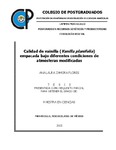| dc.contributor.author | Zamora Flores, Ana Laura | |
| dc.contributor.author | ZAMORA FLORES, ANA LAURA | |
| dc.creator | ZAMORA FLORES, ANA LAURA; 506687 | |
| dc.date.accessioned | 2018-09-20T18:29:59Z | |
| dc.date.available | 2018-09-20T18:29:59Z | |
| dc.date.issued | 2015 | |
| dc.identifier.uri | http://hdl.handle.net/10521/2843 | |
| dc.description | Tesis (Maestría en Ciencias, especialista en Fisiología Vegetal).- Colegio de Postgraduados, 2015. | es_MX |
| dc.description.abstract | El objetivo de este trabajo, fue conocer los cambios durante diferentes periodos de almacenamiento de vainilla procedente de distintas empresas beneficiadoras. Este trabajo se llevó a cabo en dos fases, en la primera se analizaron vainas procedentes de empresas beneficiadoras, ubicadas en la zona de Totonacapan en el Estado de Veracruz, México, las cuales se empacaron de forma individual en tres diferentes materiales (celofán, polietileno de baja densidad y empaques al vacío) durante 10 meses. Para la segunda fase se seleccionaron vainas procedentes de dos beneficios de la primera fase y se empacaron una y cinco vainas en cuatro tipos de empaques: celofán, celofán doble, celofán - polietileno y celofán - vacío, durante seis meses. Los resultados de la primera fase mostraron diferencias entre beneficios, principalmente en el contenido de vainillina y humedad, y sin diferencias significativas con relación a la pérdida de humedad entre los diferentes empaques. Después del segundo mes de empacado se presentó en general una pérdida de 20 % de humedad y un incremento del 1 % de vainillina. En la segunda fase, los resultados mostraron que el empaque que conservó mejor las características de calidad de la vaina fue la combinación de celofán - polietileno. Se encontraron diferencias significativas entre empaques, con relación a los cambios en la concentración de los compuestos principales entre una y cinco vainas empacadas. Los tratamientos con una vaina presentaron un aumento del contenido de vainillina, mayor pérdida de humedad y por lo consiguiente una pérdida de flexibilidad, así como mayor contenido de azúcares totales, principalmente glucosa y sacarosa. Mientras que los tratamientos con cinco vainas conservaron su flexibilidad, porcentaje de humedad y actividad de agua, pero no hubo incremento en el contenido de vainillina, ni 4-hidroxibenzaldehído. _______________ QUALITY OF VANILLA (VANILLA PLANIFOLIA) PACKAGED UNDER DIFERENT CONDITIONS OF MODIFIED ATMOSPHERES. ABSTRACT: The aim of this work was to search the changes during different periods of storage of vanilla from different curing companies. This work was carried out in two phases, the first one, the vanilla beans from four curing benefits, located in the Totonacapan area in the state of Veracruz, Mexico, were packed individually under three different materials (cellophane, low-density polyethylene and vacuum packaging) for 10 months. In the second phase beans from two curing benefits were packed lunch individually and in lots of five beans in four types of packaging: cellophane, double cellophane, cellophane - polyethylene and cellophane - vacuum, for six months. The results of the first phase showed differences between benefits, mainly in the vanillin content and moisture, and without significant differences related to the loss of moisture between the different packages. After the second month all the vanilla beans package loss of 20 per cent of moisture and experience an increase of one per cent of vanillin. In the second phase, the results showed that the packaging, which retained the best characteristics of quality of the beans, was the combination of cellophane - polyethylene. Significant differences were found between packaging with regard to changes in the concentration of the main compounds between one and five pods packaged. Treatments with one bean showed an increase of vanillin content, greater moisture loss and therefore a loss of flexibility, as well as higher content of total sugars, primarily glucose and sucrose. While the treatments with five beans retained their flexibility, percentage of humidity and water activity, but there was no increase in vanillin content, nor 4-hydroxybenzaldehyde. | es_MX |
| dc.description.sponsorship | Consejo Nacional de Ciencia y Tecnología (CONACyT). | es_MX |
| dc.format | pdf | es_MX |
| dc.language.iso | spa | es_MX |
| dc.rights.uri | http://creativecommons.org/licenses/by-nc-nd/4.0 | es_MX |
| dc.subject | Vanilla planifolia | es_MX |
| dc.subject | Beneficios | es_MX |
| dc.subject | Empacado | es_MX |
| dc.subject | Vainillina | es_MX |
| dc.subject | Curing houses | es_MX |
| dc.subject | Packaging | es_MX |
| dc.subject | Vanillin | es_MX |
| dc.subject | Fisiología Vegetal | es_MX |
| dc.subject | Maestría | es_MX |
| dc.subject.classification | CIENCIAS AGROPECUARIAS Y BIOTECNOLOGÍA::CIENCIAS AGRARIAS::AGRONOMÍA::CULTIVOS DE PLANTAS ORNAMENTALES | es_MX |
| dc.title | Calidad de vainilla (Vanilla planifolia) empacada bajo diferentes condiciones de atmósferas modificadas. | es_MX |
| dc.type | Tesis | es_MX |
| Tesis.contributor.advisor | Arévalo Galarza, Ma. de Lourdes C. | |
| Tesis.contributor.advisor | Ramírez Guzmán, Martha Elva | |
| Tesis.contributor.advisor | Valle Guadarrama, Salvador | |
| Tesis.contributor.advisor | García Osorio, Cecilia | |
| Tesis.date.submitted | 2015 | |
| Tesis.date.accesioned | 2015 | |
| Tesis.date.available | 2015 | |
| Tesis.type | Tesis | es_MX |
| Tesis.format.mimetype | pdf | es_MX |
| Tesis.format.extent | 2,278 KB | es_MX |
| Tesis.subject.nal | Envasado bajo atmósfera modificada | es_MX |
| Tesis.subject.nal | Modified atmosphere packaging | es_MX |
| Tesis.subject.nal | Plantas empacadoras | es_MX |
| Tesis.subject.nal | Packing houses | es_MX |
| Tesis.subject.nal | Plantas aromáticas | es_MX |
| Tesis.subject.nal | Essential oil crops | es_MX |
| Tesis.subject.nal | Totonacapan, Veracruz, México | es_MX |
| Tesis.rights | Acceso abierto | es_MX |
| Articulos.subject.classification | Vainilla-cultivo | es_MX |
| dc.type.conacyt | masterThesis | es_MX |
| dc.identificator | 6||31||3103||310309 | es_MX |
| dc.contributor.director | AREVALO GALARZA, MA. DE LOURDES CATALINA; 26102 | |
| dc.audience | generalPublic | es_MX |


